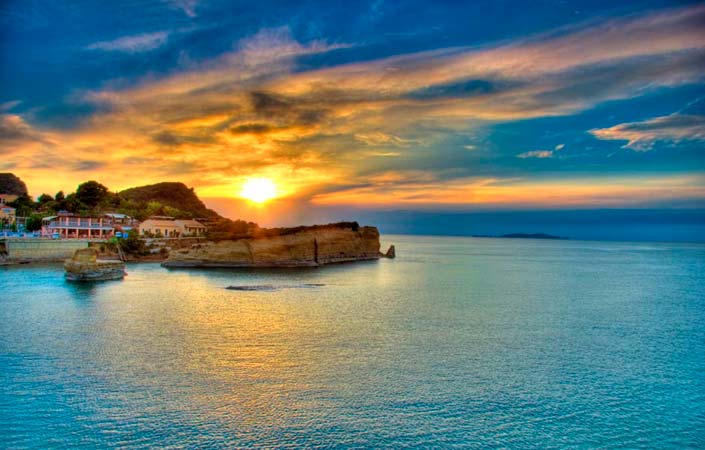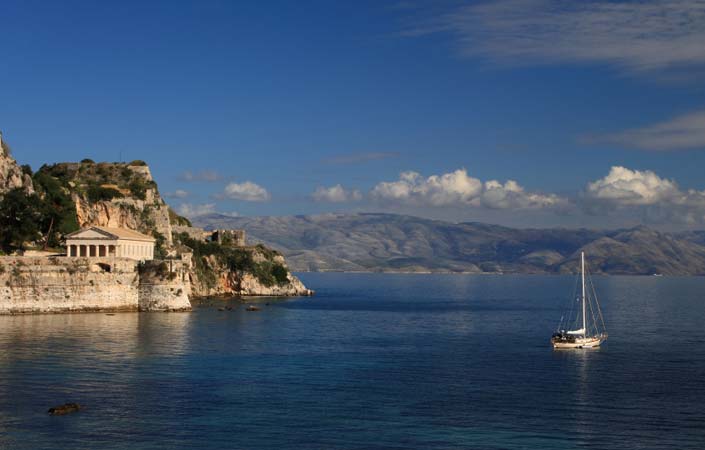Corfu
The island took its name from the nymph Korkyra, daughter of river Asopos. Neptune fell in love with Korkyra, stole her and brought her in Kerkyra (Corfu). From their union Faiakas was born the first king of the island. His brother Naysithoos, who was the father of the well known from Odyssey, Alkinoos, succeeded him.
The naval faculty of the people on the island of Faiakon was so exceptional, that they could travel with their boats even without a steer.
The foreign name Corfu emanated from the new city that was created, inside the old fortress of two hill tops (koryfes in Greek), the city of Koryfon.
Sights
- The Achileion Palace
- Pontikonisi
- Kanoni
- Bella Vista
- The historic center
- The old abandoned villages Peritheia and Sinies with houses made of rock hidden in the mountains
- the castles in Gardiki, Kassiopi and Aggelokastro
- the temples of Hera nad Artemis
- Menokratous cenotaph
History
Corfu is identified with the island of Pheacon in Omiros, the notable kingdom of Alkinoos, even if no element was found to prove it. Literary sources report various names, like Sheria, Drepani, Makri, Faiaka, Korkyra, and Corfu. The ancient myth identifies Corfu as a nymph that Neptune brought in the island. By the son of Faiaka it was named Faiakia.
The island was inhabited from the Stone age, 30000-70000 BC. In the middle of the 8th cen. BC the island was colonized by the Evians and later on 708-706 BC from Corinthian political fugitives with their leader Hersikratis. The Corinthian Colony was founded in peninsula Kanoni, in the region of Palaiopolis, transporting habits, adoration, and regime from the homeland. Corfu developed fast, acquired a naval force and it came to compete in trading with Corinthus, something that worried the metropolis and immediately sent her fleet to conform them. The naval battle took place in 664 BC and was according to Thucydides the older conflict between Greeks.
In that time the most brilliant art was made under the effect of the Korinthian artists who came in the island. Some of them are: Menokratous cenotaph, the temples of Hera and Artemis, and the eminent sculptural pediment of Gorgou. It is in the Archaeological Museum of the city and is the ancienter sculpture of Greek Art.
Kerkyras famous “Adriana ceramics” known for their solidity, in which were transported the “anthosmia” wine and her oil to the markets of Epirus and Adriatic Sea. The trade brought profits. A new monetary and gravimetric system was established, and other Ionian cities and Great Greece (Down Italy and Sicily) also adopted that. The fleet of Corfu controled the commercial streets, offering protection to the boats that travelled in the region.
Corfu remained independent until 320 BC, when the Lakedemonian general Kleonas used it as a base of operations. Corfu rebelled in 287 BC and remained free until 281 when Ptolemaios brought her back to the Epirus alliance where she remained until 225 BC.
Corfu was under the Roman dominance for more than 50 years (229BC – 337AD). The Romans used the islands navy and ports and in return gave them freedom in administration, laws and currency.
Corfu had a big development in the 8th century. But her preferential position that conduced to her development also brought a lot of raiders to her coasts.
Venice the big power of the time occupied her castles “offering” protection. Venice was a source of sufferings but also a door to knowledge for Corfu. A lot of times the people rebelled because of the sufferings. In Corfu took place the first civil revolution against noblemen.
Frequent were the pirate raids mainly by the Turks. In spite of all these Corfu was a shelter for those who came to avoid the Ottoman occupation.
The mixture of the local element with refugees from Greece created a special feature and variety in social events.
Information
Access-Transportation
By Bus
From Thessaloniki and Athens through Igoumenitsa port
Corfu KTEL (Public Bus Service)
greenbuses.gr
0030 26610 28928
Thessaloniki KTEL (Public Bus Service)
Macedonia Public Bus Service
0030 2310 595409
Athens KTEL (Public Bus Service) – Kifisos station
0030 210 5129443
By plane
Corfu airport “I. Kapodistrias”
0030 26610 89600
Distance: 1,5 km from Corfu city
By Ship
From Igoumenitsa and Patra port
Corfu port authority 0030 26613 65200
Igoumenitsa port authority 0030 26650 99400
Patra port authority 0030 2613 615400
Useful
Area: 585,3 sq km
Capital: Corfu (Kerkyra)
Corfu prefecture administratively belongs to the Region of Ionian Islands.

